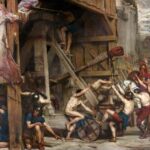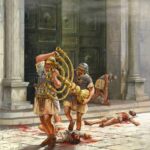Chapters
Verulamium was the third-largest city in Rome in Britain. For some time it was even the provincial capital. Burned during the Boudica revolts, it regained its splendour in the following years, traces of which are still being discovered today. Many public buildings have been erected in the city, including Britain’s largest theatre.
The city was inhabited for some time after the legions left the island, but the population gradually moved to one area of the city, which probably transformed over time into a new settlement – Saint Albans. The buildings in the abandoned Verulanium were gradually demolished, while the recovered stone and brick were used to build houses and other structures in Saint Albans.
Theatre
The theatre in Verulamium was built around 140 CE at the site of an earlier Celtic chapel, next to the main Roman road. In 160, a unique stage was erected – unlike typical Roman theatres, it was placed on a dais, similar to the theatrical buildings built today; such a solution provided much better acoustics, which was of great importance especially when holding religious rituals, staging theatre performances or during concerts. As early as 10 years later, that is around 170, the theater was expanded, incl. a large tenement house between it and the nearby stalls. Just behind the tenement house there is an underground temple (its relics, secured with a metal grate, are still visible today). The shape visible today was obtained during the last expansion, i.e. around 300. At that time, the rear part of the stage was roofed, and the final shape of the stands could accommodate a total of approx. 7 thousand. viewers.
From the side of the street, by the outer wall of the amphitheatre, there are stalls with additional rooms – for magazines or places to sleep. In addition, a monumental triumphal arch was erected right next to the building’s wall, the relics of which have been preserved to this day.
The amphitheatre in Verulamium has become a venue for cultural events: plays and pantomimes were staged there, concerts were organized, and religious ceremonies were celebrated – incl. priests led processions to him from a nearby temple. But it was also a place of other typically Roman entertainment – in the arena, there were wrestling, fights with wild animals, or gladiator fights.
Researchers say that the amphitheatre was abandoned around 380 CE. Some people see the reasons for this in the religious reorientation of the Empire – a significant number of events organized in the theatre were typically pagan in nature. However, this claim does not seem to be accurate, as research has shown that a nearby pagan temple was in use and even extended many years after that date.
The ruins of the Verulamium amphitheatre were discovered in 1847, and further research took place in 1935 and 1957.
Theatre in Verulamium today
The monument, together with the ruins of neighbouring stalls, is fully open to the public. After the modernization of the infrastructure, which took place in 2014, the accessibility of the facility was improved, and now it can also be visited by people with disabilities.
It is an unusual structure that is definitely worth seeing. A walk around the arena allows you to experience unforgettable experiences, especially when accompanied by the vapours of the English fog.







